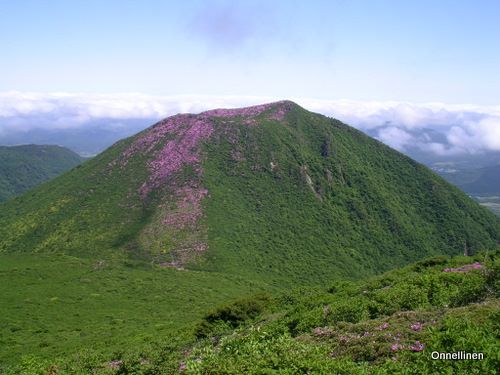One of the salary-mens at work is from a real farmer family; living at the countryside quite surrounded by rice paddies and woodlands. He is out from ordinary, those people who manage to work in an office while taking care of crops and other duties of farming are not many. We visited him at the weekend to help in rice-planting. The following story is more or less about rice.
 The farm is located an hour drive away from Oita City,
The farm is located an hour drive away from Oita City, at the Ōno-machi, behind some dense forests and rice fields. The absence of people, read: rural depopulation, was replaced by cats and kittens (these being the cute and small ones).
 Muddy rice paddy behind us,
Muddy rice paddy behind us, rice seedlings on our hands, our team is ready to start planting. Soon after it started to rain but it didn't interrupt our grand mission.
 The pre-grown rice is bought from an agricultural dealer.
The pre-grown rice is bought from an agricultural dealer. Growing the seedlings by oneself is troublesome, though rice can grow from a normal supermarket grains. The reason for using seedlings is because the they are less vulnerable to diseases and weeds than bare seeds.
 The first step to the mud pool felt funny.
The first step to the mud pool felt funny. Water in the paddy is cool but not really cold. Apparently rice doesn't need a flooded growing base (a common belief in the past), but still all the fields for rice are flooded. The over watering keeps effectively weeds away. We used white guide threads to plant straight lines so to later make the harvesting easier.
 These sheets have been grown in a nursery,
These sheets have been grown in a nursery, and one costs about 5,000 yen. In contrast, super markets sell 25 kg rice for 5,000 yen. Knowing this, it is easy to see why so few choose the career of a rice farmer (if it ever is a selection). It is so much easier to hop in a supermarket around the block, especially since 25 kg feeds an average Japanese for almost half a year.
 Knee-deep in Japanese culture.
Knee-deep in Japanese culture. A positive side is that the brown slush has a cooling effect. However, the blood-sucking insects that paddle and swim in the sludge have a very itchy effect. The red stings in my ankles itch even while writing this, which makes me truly respect the people who plant rice for days and days with bare feet.
 After some hours of hand-planting,
After some hours of hand-planting, it was the time to see the revolution of a machine.
 The revolution was named convincingly "Lovely mini".
The revolution was named convincingly "Lovely mini". While for five of us it would have taken about half a day to bed the entire paddy by hand, the cute but squeaky machine could complete the same area within 40 or 50 minutes.
 And not only was the planting apparatus faster,
And not only was the planting apparatus faster, but by using it one would avoid the feisty insects and chronic backache, which makes old rice farmers look like hunchbacks.
 As the day turned to an afternoon our work came to an end.
As the day turned to an afternoon our work came to an end. Three months later it is harvesting time, and this specific rice paddy will yield about 1 ton of delicious sticky rice.
Dirty and tired, we were spent the rest of the afternoon bathing in a onsen, and talking over a bbq. It was a memorable day and one of the best Sundays in every respect!











































